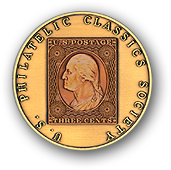In the United States, stamps were first issued just prior to the mid-Nineteenth Century. But mail had been transported by evolving postal systems from the late-Seventeenth Century in the American colonies and then in the new country created by the American Revolution. Since the country was founded largely as a group of colonists from Great Britain, early letters were transported across the Atlantic Ocean or between towns in the different colonies. A majority of early letters show evidence of transport by ship. Many letters were carried by hand and demonstrate no postal markings, but there are many letters transported by colonial post which in the period just prior to the Revolution bear markings which indicate the site of origin, the amount of postage, and whether the postage was paid. Since there were no envelopes until the 1840’s, all of these early correspondences are folded letters with addresses on the outer surface of the single large sheet of paper. Sealing was done with sealing wax, either sticks or wafers. Some letters were sent by special messengers, some by express, and some free because the writer or recipient was a personage who had the franking privilege. While early postmarks are all handwritten, in the later colonial period many larger towns employed handstamps for the town name and there were special dating handstamps at a few locations. These letters are termed by collectors to be stampless covers. All early mail in the United States was by means of stampless covers.
With the establishment of a new country the United States had its own post office system which was centralized in the seat of government. Agents were hired and paid to perform services. Owners of freight lines and stages bid on contracts to carry the mail on a regular basis over a particular route, stopping at the various towns along the route. Post offices were established in each of these towns to accept and hold letters for delivery. The postal fees were established by Congress and related to the distance a letter was carried, the number of sheets of paper in the letter, and the weight.

As time passed, a single large city such as Boston, Massachusetts utilized many different postal markings. And letters passing through Boston show a divergent array of many different postal usage’s, such as letters coming from and going to many different towns and many different countries with all sorts of special postal markings for special postal usage’s. In addition to the horse and wagon, steamboats began to transport mail in the early-Nineteenth Century. Trains were becoming an important method of mail transportation beginning in the late 1830’s with the rapidly expanding track systems. And each different train company or route agent had its own postal markings, too!

At the beginning, most mail was sent postage due – the recipient paid the postage when he or she picked up the letter from the receiving post office. Gradually, that practice changed so some mail was prepaid and some was sent due. “PAID” markings were used to denote prepayment. Postal reform gradually occurred with a great reduction in the fees charged on letters. In 1845 the postage fees were reduced to five cents and ten cents for letters carried for less or greater than 400 miles.



1. American Stampless Cover Catalog. Vol. 1, 1997, David G. Phillips, N. Miami, Florida.
2. American Stampless Cover Catalog. Vol. 2, 1987, David G. Phillips, N. Miami, Florida.
3. The Posted Letter in Colonial and Revolutionary America. Alex ter Braake, 1975, American Philatelic Research Library, State College, Pennsylvania.
4. Postal Markings of Boston, Massachusetts to 1890. Maurice Blake and Wilbur Davis, 1949, Severn-Wylie-Jewett, Portland, Maine.
5. The First Hundred Years of United States Territorial Postmarks, 1787-1887. Carroll Chase and Richard Cabeen, 1950, American Philatelic Society, State College, Pennsylvania.
6. Vessel-named Markings on United States Inland and Ocean Waterways, 1810-1890. James W. Milgram, M.D., 1994, Published Collectors Club of Chicago.

